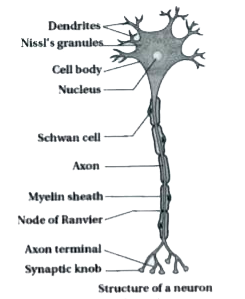Describe the structure of neuron with diagram.
Neurons are functional unit of neural system.
In microscopic structure of neuron three main parts are observed :
(1) Cell body (2) Dendrites (3) Axon.
(1) Cell body : Body of neuron is called cyton. Cyton may be oval, round or stellate shaped. Cytoplasm of neuron is called Neuroplasm. Big round nucleus is present. In the centre of the cyton. Neuroplasm, consist of cellular organelles, small basophilic granules (Nissl.s granules) Nissl.s granules are mostly near the nucleus.
(2) Dendrites : Divides, redivides and project out of the cyton. It also contains Nissl.s granules. Dendrites transmit impulses towards the cell body.
(3) Axon : Is a long fibre, the distal end of it is branched. Each branch terminates into bulb like structure called Synaptic knob.
Synaptic knob : It has synaptic vesicles containing chemicals called Neurotransmitter.

The axon transmit nerve impulses away from the cyton to a synapse or to a NeuroMuscular Junction.
Types of neurons : Based on the number of axon and dendrites, the neurons are divided into three types :
(1) Multipolar : One axon and two or many dendrites. i.e. : cerebral cortex.
(2) Bipolar : One axon and one dendrite e.g. : retina of eye.
(3) Unipolar : Cell body with one axon only e.g. : present in embryonic stage.
Two types of axons are present accordingly neuron is
(i) Myelinated neuron (ii) Nonmyelinated neuron.
(i) Medullated neuron : The myelinated nerve fibres are enveloped with Schwann cells which form a myelin sheath around the axon.
The gaps between two adjacent myelin sheaths are called nodes of Ranvier
Myelinated nerve fibres are found in cranial nerves and spinal nerves.
(ii) Non-myelinated neuron : They are enveloped by a Schwann.s cells but myelin layer is not formed around the axon.
It is found in somatic neural system and autonomous neural system.
Topper's Solved these Questions
- BOOK - KUMAR PRAKASHANCHAPTER - NEURAL CONTROL AND COORDINATIONEXERCISE - SECTION - B (DIFFERENCE/SCIENTIFIC REASONS)11videos
NEURAL CONTROL AND COORDINATION
- BOOK - KUMAR PRAKASHANCHAPTER - NEURAL CONTROL AND COORDINATIONEXERCISE - SECTION - C (DEFINITION/EXPLANATION - TERMS/IMPORTANCE)21videos
NEURAL CONTROL AND COORDINATION
- BOOK - KUMAR PRAKASHANCHAPTER - MORPHOLOGY OF FLOWERING PLANTSEXERCISE - questions from module -(Important MCQ for NEET)4videos
MORPHOLOGY OF FLOWERING PLANTS
- BOOK - KUMAR PRAKASHANCHAPTER - PHOTOSYNTHESIS IN HIGHER PLANTSEXERCISE - FILL IN BLANKS10videos
PHOTOSYNTHESIS IN HIGHER PLANTS
Similar Questions
Describe the structure of a stoma with a diagram.
View SolutionDescribe internal structure of anther (diagram is not expected).
View SolutionDescribe the structure of chromosomes with a suitable diagram.
View SolutionDescribe the structure of chromosome with a suitable diagram.
View SolutionDescribe the structure of sex chromosomes with the help of labelled diagram.
View SolutionDescribe the structure of anatropus ovule with the help of labelled diagram.
View SolutionDescribe the structure of human spermatozoan with a diagram.
View SolutionDescribe the structure of chloroplast with the help of diagrams.
View SolutionDescribe the structure of a sacromere with the help of a labelled diagram.
View SolutionDescribe the structure of a human kidney with the help of a labelled diagram.
View Solution

